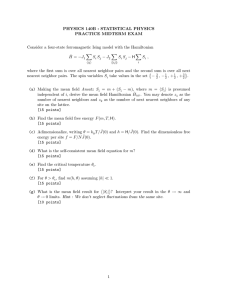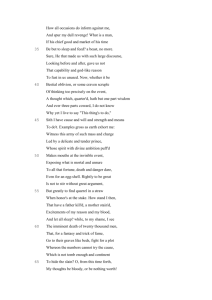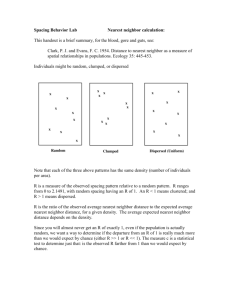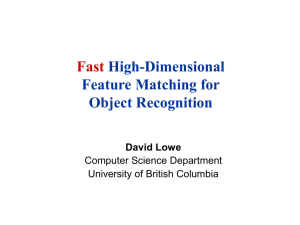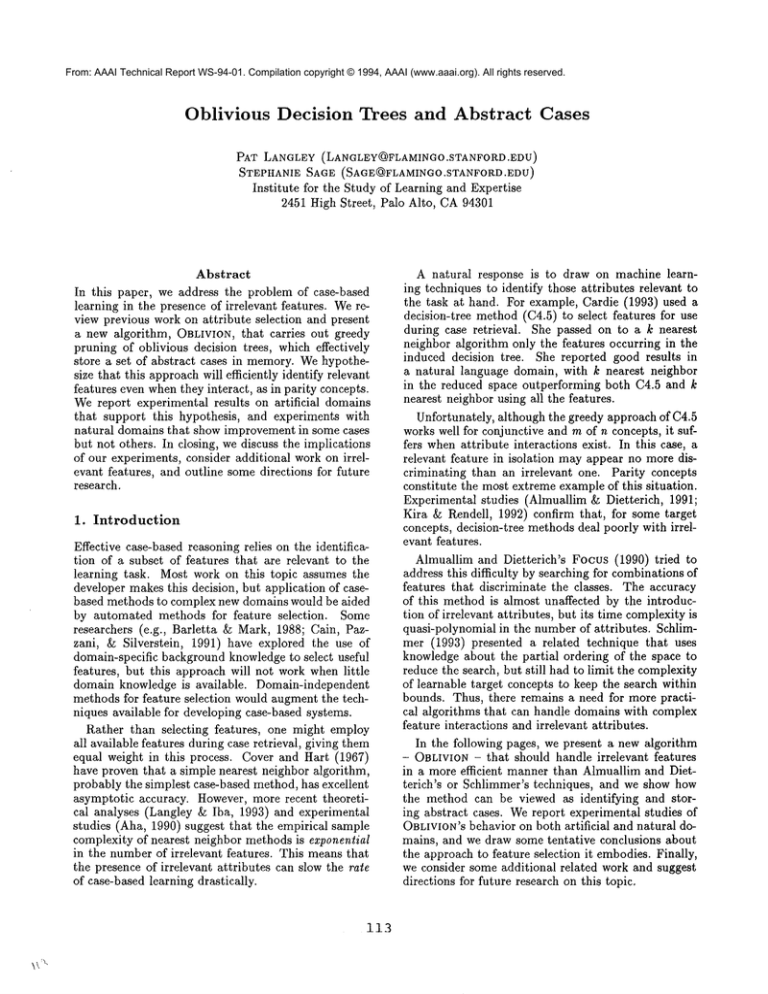
From: AAAI Technical Report WS-94-01. Compilation copyright © 1994, AAAI (www.aaai.org). All rights reserved.
Oblivious
Decision
Trees and Abstract
Cases
PAT LANGLEY(LANGLEY@FLAMINGO.STANFORD.EDU)
STEPHANIESAGE (SAGE~FLAMINGO.STANFORD.EDU)
Institute for the Study of Learning and Expertise
2451 High Street, Palo Alto, CA94301
Abstract
In this paper, we address the problem of case-based
learning in the presence of irrelevant features. Wereview previous work on attribute selection and present
a new algorithm, OBLIVION, that carries out greedy
pruning of oblivious decision trees, which effectively
store a set of abstract cases in memory. Wehypothesize that this approach will efficiently identify relevant
features even whenthey interact, as in parity concepts.
Wereport experimental results on artificial
domains
that support this hypothesis, and experiments with
natural domains that show improvement in some cases
but not others. In closing, we discuss the implications
of our experiments, consider additional work on irrelevant features, and outline some directions for future
research.
1. Introduction
Effective case-based reasoning relies on the identification of a subset of features that are relevant to the
learning task. Most work on this topic assumes the
developer makes this decision, but application of casebased methods to complex new domains would be aided
by automated methods for feature selection.
Some
researchers (e.g., Barletta ~ Mark, 1988; Cain, Pazzani, & Silverstein,
1991) have explored the use of
domain-specific background knowledge to select useful
features, but this approach will not work when little
domain knowledge is available.
Domain-independent
methods for feature selection would augment the techniques available for developing case-based systems.
Rather than selecting features, one might employ
all available features during case retrieval, giving them
equal weight in this process. Cover and Hart (1967)
have proven that a simple nearest neighbor algorithm,
probably the simplest case-based method, has excellent
asymptotic accuracy. However, more recent theoretical analyses (Langley &: Iba, 1993) and experimental
studies (Aha, 1990) suggest that the empirical sample
complexity of nearest neighbor methods is exponential
in the number of irrelevant features. This means that
the presence of irrelevant attributes can slow the rate
of case-based learning drastically.
i13
A natural response is to draw on machine learning techniques to identify those attributes relevant to
the task at hand. For example, Cardie (1993) used
decision-tree method(C4.5) to select features for use
during case retrieval.
She passed on to a k nearest
neighbor algorithm only the features occurring in the
induced decision tree. She reported good results in
a natural language domain, with k nearest neighbor
in the reduced space outperforming both C4.5 and k
nearest neighbor using all the features.
Unfortunately, although the greedy approach of C4.5
works well for conjunctive and m of n concepts, it suffers whenattribute interactions exist. In this case, a
relevant feature in isolation may appear no more discriminating than an irrelevant one. Parity concepts
constitute the most extreme example of this situation.
Experimental studies (Almuallim & Dietterich, 1991;
Kira & Rendell, 1992) confirm that, for some target
concepts, decision-tree methodsdeal poorly with irrelevant features.
Almuallim and Dietterich’s Focus (1990) tried
address this difficulty by searching for combinations of
features that discriminate the classes. The accuracy
of this method is almost unaffected by the introduction of irrelevant attributes, but its time complexityis
quasi-polynomial in the number of attributes. Schlimmer (1993) presented a related technique that uses
knowledge about the partial ordering of the space to
reduce the search, but still had to limit the complexity
of learnable target concepts to keep the search within
bounds. Thus, there remains a need for more practical algorithms that can handle domains with complex
feature interactions and irrelevant attributes.
In the following pages, we present a new algorithm
- OBLIVION - that should handle irrelevant
features
in a more efficient manner than Almuallim and Dietterich’s or Schlimmer’s techniques, and we show how
the method can be viewed as identifying and storing abstract cases. Wereport experimental studies of
OBLIVION’S
behavior on both artificial and natural domains, and we draw some tentative conclusions about
the approach to feature selection it embodies. Finally,
we consider some additional related work and suggest
directions for future research on this topic.
2. Induction
of Oblivious
Decision
3. Experimental
Trees
Our research goal was to develop an algorithm that
handled both irrelevant features and attribute interactions without resorting to expensive, enumerative
search. Our response draws upon the realization that
both Almuallim and Dietterich’s and Schlimmer’s approaches construct oblivious decision trees, in which
all nodes at the same level test the same attribute. Although these methods use forward selection (i.e., topdownsearch) to construct oblivious decision trees, one
can also start with a full oblivious decision tree that
includes all the attributes,
and then use pruning or
backward elimination to remove features that do not
aid classification accuracy. The advantage of the latter approach is that accuracy decreases substantially
whenone removesa single relevant attribute, even if it
interacts with other features, but remains unaffected
when one prunes an irrelevant or redundant feature.
OBLIVION
is an algorithm that instantiates this idea.
The method begins with a full oblivious tree that incorporates all potentially relevant attributes and estimates this tree’s accuracy on the entire training set,
using a conservative technique like n-way cross validation. OBLIVION then removes each attribute in turn,
estimates the accuracy of the resulting tree in each
case, and selects the most accurate. If this tree makes
no more errors than the initial one, OBLIVION replaces
the initial tree with it and continues the process. On
each step, the algorithm tentatively prunes each of the
remaining features, selects the best, and generates a
new tree with one fewer attribute. This continues until the accuracy of the best pruned tree is less than
the accuracy of the current one. Unlike Focus and
Schlimmer’s method, OBLIVION’Stime complexity is
polynomial in the number of features, growing with
the square of this factor.
There remain a few problematic details, such as constructing an initial tree that is exponential in the number of initial attributes, determining the order of the
retained attributes, and passing the results to some
learning method. However,none of these steps is actually necessary. The key lies in realizing that an oblivious decision tree is equivalent to a nearest neighbor
scheme that ignores some features. In this view, each
path through the tree corresponds to an abstract case
that summarizes an entire set of training instances.
Because pruning can Produce impure partitions of the
training set, each such case specifies a distribution of
class values. Whenan instance matches a case’s conditions, it simply predicts the most likely class. If training data are sparse and a test instance fails to match
any stored abstract case, one finds the nearest cases
(i.e., with the most matchedconditions), sums the class
distributions for each one, and predicts the most likely
class. This insight into the relation between oblivious
decision trees and nearest neighbor algorithms was an
unexpected benefit of our work.
114
Studies
of OBLIVION
Weexpected OBLIVION
to scale well to domains that
involve manyirrelevant features. To test this prediction, we designed an experimental study with four artificial Boolean domains that varied both the degree of
feature interaction and the number of irrelevant features. Weexaminedtwo target concepts - five-bit parity and a five-feature conjunction - in the presence of
both zero and three irrelevant attributes. For each condition, we randomly generated 20 sets of 200 training
cases and 100 test cases, and measured classification
accuracy on the latter. In addition to varying the two
domain characteristics,
we also examined three induction algorithms - simple nearest neighbor (which does
not carry out attribute selection), C4.5 (which employs
a forward greedy selection), and OBLIVION
(i.e., nearest neighbor with backward greedy selection). Finally,
we varied the number of training instances available
before testing, to obtain learning curves.
Wehad a number of hypotheses about the outcomes
of this study. First, we expected C4.5 to be unaffected
by irrelevant attributes in the conjunctive domain, but
to suffer on the parity concept, because none of the
five relevant features wouldappear diagnostic in isolation. In contrast, we predicted that nearest neighbor
would suffer equally on both target concepts, but that
OBLIVION’S ability to remove irrelevant features even
in the presence of feature interaction wouldlet it scale
well on both concepts. Finally, we hypothesized that
OBLIVION’s learning curve would closely follow that
for nearest neighbor when no irrelevants were present,
but that it would mimic C4.5 in the absence of feature
interactions.
Figure 1 (a) shows the learning curves on the parity
target concept when only the five relevant attributes
and no irrelevant ones are present in the data. In this
experimental condition, nearest neighbor and OBLIVIONincrease their accuracy at the same rate, but surprisingly, C4.5 actually learns somewhatmore rapidly.
The situation changes drastically in Figure 1 (b), which
presents the results whenthere are three irrelevant features. Here the learning curves for both nearest neighbor and C4.5 have flattened considerably. In contrast,
the learning rate for OBLIVION
is almost unaffected by
their introduction. A different situation holds for the
conjunctive target concept (not shown). In this case,
all three algorithms require about the same number of
instances to reach perfect accuracy whenno irrelevants
are present, with nearest neighbor taking a surprise
lead in the early part of training. The introduction of
irrelevant attributes affects nearest neighbor the most,
and C4.5’s learning curve is somewhat less degraded
than that for OBLIVION.
These results support our hypothesis about OBLIVION’s ability to scale well to domains that have both
irrelevant features and interaction amongrelevant at-
(a)
(b)
"-}’-~-~’’~
l 2r
~~.-]
Oblivion
Obllvlon
Nearestneighbor........
04.5 w/o pruning
Nearest neighbor ........
04.5 w/o pruning
I
I
I
I
I
20
40
60
80
100
I
I
I
I
I
120 140 160 180 200
Number
of training instances
I
I
I
I
20
40
60
80
I
100
I
I
I
!
I
120 140 160 180 200
Number
of trainingInstances
Figure 1. Learningcurves for nearest neighbor, C4.5 without pruning, and OBLIVION
on the five-bit parity concept given (a)
zero irrelevant attributes and (b) three irrelevant attributes. The error bars indicate 95%confidenceintervals.
tributes.
However, we also wanted to evaluate the
importance of this finding on natural data. Holte’s
(1993) results with the UCI repository suggest that
these domains contain many irrelevant features but
few interactions amongrelevant ones; in this case, we
would expect C4.5 and OBLIVION to outperform nearest neighbor on them. But it is equally plausible that
these domains contain many relevant but redundant
attributes, in which case we wouldobserve little difference in learning rate amongthe three algorithms.
In four of the UCI domains - Congressional voting, mushroom, DNApromoters, and breast cancer we found little difference in the behavior of OBLIVION, C4.5, and nearest-neighbor. All three algorithms
learn rapidly and the learning curves (not shown) are
very similar. Inspection of the decision trees learned
by C4.5 and OBLIVIONin two of these domains revealed only a few attributes. Combinedwith the fact
that nearest neighbor performs at the same level as the
other methods, this is consistent with the latter explanation for Holte’s results, that these domains contain
1largely redundant features.
One domain in which Holte found major differences
was king-rook vs. king-pawn chess endgames, a twoclass data set that includes 36 nominal attributes. This
suggested that it might contain significant attribute interactions, and thus might give different outcomes for
the three algorithms. Figure 2 (a) gives the resulting learning curves, averaged over 20 runs, in which
OBLIVION’S accuracy on the test set is consistently
about ten percent higher than that for nearest neighbor, though presumably the latter would eventually
1A forward-selection variant of OBLIVION
(basically
greedy version of the Focus algorithm) also producedvery
similar curves on these domains,providing further evidence
that they do not involve both feature interactions and irrelevant attributes.
115
catch up if given enough instances. However, C4.5
reaches a high level of accuracy even more rapidly than
OBLIVION, suggesting that this domain contains many
irrelevant attributes, but that there is little interaction
among the relevant ones. Inspection of the decision
trees that C4.5 generates after 500 instances is consistent with this account, as they contain about ten of
the 35 attributes, but only a few more terminal nodes
than levels in the tree, makingthem nearly linear and
thus in the same difficulty class as conjunctions.
Figure 2 (b) shows encouraging results on another
domain, this time averaged over ten runs, that involves
prediction of a word’s specific semantic class from the
surrounding context in the sentence. These data include 35 nominal attributes (some with many possible values) and some 40 word classes. Nearest neighbor does very poorly on this domain, suggesting that
many of the attributes are irrelevant. Inspection of
C4.5’s and OBLIVION’s
output, which typically retain
about half of the attributes, is consistent with this explanation. In the latter part of the learning curves,
OBLIVION’s
accuracy pulls slightly ahead of that for
C4.5, but not enough to suggest significant interaction
amongthe relevant attributes. Indeed, Cardie (1993)
reports that (on a larger training set) nearest neighbor
outperforms C4.5 on this task when the former uses
only those features found in the latter’s decision tree.
This effect cannot be due to feature interaction, since
it relies on C4.5’s greedy forward search to identify features; instead, it maycomefrom the different representational biases of decision trees and case-based methods, which would affect behavior on test cases with
imperfect matches.
The above findings indicate that manyof the available data sets contain few truly irrelevant features, and
none of these appear to involve complexfeature interactions. These observations mayreflect preprocessing
(a)
(b)
o=
~ ....
,/’~..~..-~-
....
0. ¢D
d
Oblivion
Nearestneighbor........
C4.5w/pruning
,
i
0
50
i
i
i
i
i
i
I
I
-
"
....
.~ ......
2 ......
-_’ ....
2
]
//
I
Nearestneighbor........
C4.5w/pruning
i
100
100 150 200 250 300 350 400 450 500
Number
of training
instances
l
200
I
300
I
i
l
400
500
600
Number
of trainingInstances
Figure 2. Predictive accuracy as a function of training instances for nearest neighbor, 04.5 with pruning, and OBLIVION
on
(a) classifying chess endgamesand (b) predicting a word’s semantic class.
of many of the UCI databases by domain experts to
removeirrelevant attributes and to replace interacting
features with better terms. The voting records, which
contain only 16 key votes as identified by the Congressional Quarterly, provide an extreme example of the
first trend. As machine learning starts to encounter
new domains in which few experts exist, such data sets
mayprove less representative than artificial ones.
The experiments with artificial
domains, reported
earlier, revealed clear differences in the effect of irrelevant attributes and feature interactions on the behavior of nearest neighbor, C4.5, and OBLIVION.
The rate
of learning for the nearest neighbor method decreased
greatly with the addition of irrelevant features, regardless of the target concept. In contrast, irrelevant attributes hurt C4.5 for the five-bit parity concept but
not the five-feature conjunction; top-down greedy induction of decision trees scales well only whenthe relevant features (individually) discriminate amongthe
classes. In contrast, the learning rate for OBLIVION
was largely unaffected by irrelevant features for either the conjunctive or parity concepts, presumably
because its greedy pruning method was not misled by
interactions amongthe relevant features.
4. Discussion
Wehave already reviewed the previous research that
led to our work on OBLIVION, and we have drawn some
tentative conclusions about the algorithm’s behavior
from our experimental results. Here we consider some
additional related work on induction, along with directions for future research.
Kira and Rendell (1992) have followed a somewhat
different approach to feature selection. For each attribute A, their RELIEFalgorithm assigns a weight WA
116
that reflects the relative effectiveness of that attribute
in distinguishing the classes. The system then selects
as relevant only those attributes with weights that exceed a user-specified threshold, and passes these features, along with the training data, to another induction algorithm such as ID3. Comparative studies on
two artificial domainswith feature interactions showed
that, like Focus, the RELIEFalgorithm was unaffected
by the addition of irrelevant features on noise-free data,
and that it was less affected than Focus (and much
more efficient) on noisy data.
The above algorithms filler attributes before passing
them to ID3, but John, Kohavi, and Pfleger (in press)
have explored a wrapper model that embeds a decisiontree algorithm within the feature selection process, and
Caruana and Freitag (in press) have described a similar
scheme. Each examined greedy search through the attribute space in both the forward and backward directions, including variants that supported bidirectional
search. John et al. found that backward elimination produced more accurate trees than C4.5 in two
domains but no differences in others, whereas Caruana and Freitag reported that all of their attributeselection methods produced improvements over (unpruned) ID3 in a single domain.
One can also combine the wrapper idea with nearestneighbor methods, as in OBLIVION.Skalak (in press)
has recently examined a similar approach, using both
Monte Carlo sampling and random mutation hill climbing to select cases for storage, with accuracy on the
training set as his evaluation measure. Both approaches
led to reductions in storage costs on four domainsand
someincreases in accuracy, and the use of hill climbing
to select features gave further improvements. Moore,
Hill, and Johnson (in press) have also embeddednearest neighbor methods within a wrapper scheme. However, their approach to induction searches not only the
space of features, but also the number of neighbors
used in prediction and the space of combination functions. Using a leave-one-out scheme to estimate accuracy on the test set, they have achieved significant
results on two control problems that involve the prediction of numeric values.
Some researchers have extended the nearest neighbor approach to include weights on attributes that
modulate their effect on the distance metric. For example, Cain et al. (1991) found that weights derived
from a domain theory increased the accuracy of their
nearest-neighbor algorithm. Aha (1990) presented
algorithm that learned the weights on attributes, and
showed that its empirical sample complexity grew only
linearly with the numberof irrelevant features, as compared to exponential growth for simple nearest neighbor. In principle, proper attribute weights should produce more accurate classifiers than variants that simply omit features. However, search through the weight
space involves more degrees of freedom than OBLIVION’s search through the attribute space, making their
relative accuracy an open question for future work.
Clearly, our experimental results are somewhatmixed
and call out for additional research. Future studies
should examine other natural domains to determine
if feature interactions arise in practice. Also, since
OBLIVION uses the leave-one-out scheme to estimate
accuracy, we predict it should handle noise well, but
we should follow Kira and Rendell’s lead in testing
this hypothesis experimentally. OBLIVION’s
simplicity
also suggests that an average-case analysis would prove
tractable, letting us compare our experimental results
to theoretical ones. Weshould also compare OBLIVION’s behavior to other methods for selecting relevant
features, such as those mentioned above.
Despite the work that remains, we believe that our
analysis has revealed an interesting relation between
oblivious decision trees and abstract cases, and ’that
our experiments provide evidence that one such algorithm outperforms simpler case-based learning methods in domains that involve irrelevant attributes. We
anticipate that further refinements to OBLIVION
will
produce still better results, and that additional experiments will provide a deeper understanding of the conditions under which such an approach is useful.
Acknowledgements
Thanks to David Aha, George John, Karl Pfleger, Russ
Greiner, Ronny Kohavi, Bharat Rao, and Jeff Schlimmer for useful discussions, to Ray Mooney,for making
his modified C4.5 code available, and to Claire Cardie,
for providing her natural language data. Siemens Corporate Research and Stanford University provided resources that aided our research. This work was supported in part by ONRGrant No. N00014-94-1-0505.
References
Aha, D. (1990). A study of instance-based algorithms
for supervised learning tasks: Mathematical, empirical, and psychological evaluations. Doctoral dissertation, Department of Information ~ Computer Science, University of California, Irvine.
Almuallim, H., & Dietterich, T. G. (1991). Learning
with many irrelevant features. Proceedings of the
Ninth National Conference on Artificial Intelligence
(pp. 547-552). San Jose, CA: AAAIPress.
Barletta, R., & Mark, W. (1988). Explanation-based
indexing of cases. Proceedings of the Seventh National Conferenceon Artificial Intelligence (pp. 541546). St. Paul, MN:AAAIPress.
Cain, T., Pazzani, M. J., &Silverstein, G. (1991). Using domain knowledgeto influence similarity judgements. Proceedings of the DARPAWorkshop on
Case-Based Reasoning (pp. 191-199). Washington,
DC: AAAIPress.
Cardie, C. (1993). Using decision trees to improve
case-based learning. Proceedings of the Tenth International Conference on Machine Learning (pp. 2532). Amherst, MA: Morgan Kaufmann.
Cover, T. M., ~ Hart, P. E. (1967). Nearest neighbor
pattern classification.
IEEE Transactions on Information Theory, 13, 21-27.
Holte, R. (1993). Very simple classification rules perform well on most commonly used domains. Machine Learning, 11, 63-91.
Kira, K., & Rendell, L. (1992). A practical approach
to feature selection. Proceedings of the Ninth International Conference on Machine Learning (pp. 249256). Aberdeen, Scotland: Morgan Kaufmann.
Langley, P., &5Iba, W. (1993). Average-case analysis
of a nearest neighbor algorithm. Proceedings of the
Thirteenth International Joint Conference on Artificial Intelligence (pp. 889-894). Chambery,France.
Moore, A. W., Hill, D. J., & Johnson, P. (in press).
An empirical investigation of brute force to choose
features, smoothers, and function approximators. In
S. Hanson, S. Judd, & T. Petsche (Eds.), Computational learning theory and natural learning systems
(Vol. 3). Cambridge, MA:MITPress.
Quinlan, J. R. (1986). C~.5: Programs for machine
learning. San Mateo, CA: Morgan Kaufmann.
Schlimmer, J. C. (1987). Efficiently inducing determinations: A complete and efficient search algorithm
that uses optimal pruning. Proceedings of the Tenth
International Conference on Machine Learning (pp.
284-290). Amherst, MA: Morgan Kaufmann.
117

